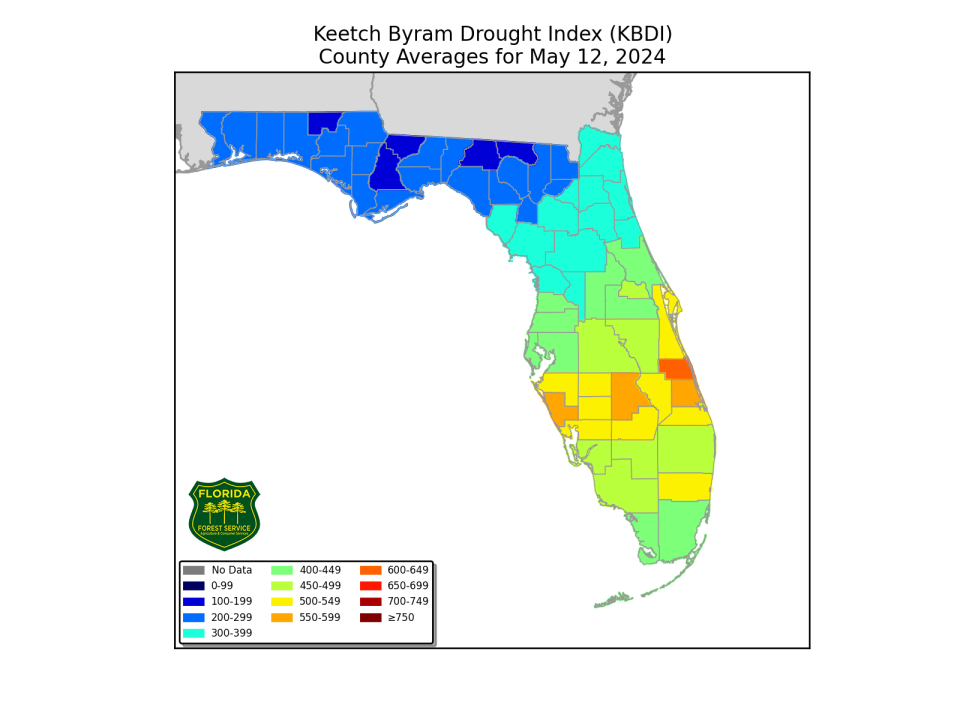Burn bans in place for 3 Florida counties as lack of rain ramps up fire dangers. What to know
Florida is a bit conflicted these days. While the Panhandle and North Florida are seeing plenty of rain — sometimes to the extreme and including tornadoes — Central Florida from the East Coast to the West Coast is parched.
Conditions have gotten so bad some counties have issued burn bans as the danger for wildfires increases.
Here's the latest on drought conditions around the state.
Indian River County tops Florida in drought index

According to the May 12 Keetch-Byram Drought Index, drought conditions in Florida are the worst in Indian River County, with Sarasota, Highlands and St. Lucie counties slightly better but worse than other counties around the state.
Dry conditions extend from Brevard County south to Broward County on Florida's East Coast to Manatee County south to Charlotte County on Florida's West Coast.
Rain amounts can vary so much in the state that conditions are better in Palm Beach County than Martin County to its north and Broward County to its south.
Keetch-Bryam Drought Index for the driest counties in Florida
Thirteen counties in Florida have KBDI numbers higher than 500, indicating dryness, according to the Florida Department of Agriculture.
Indian River County: 602
Highlands County: 572
St. Lucie County: 563
Sarasota County: 553
Martin County: 542
DeSoto County: 540
Hardee County: 537
Brevard County: 533
Manatee County: 529
Charlotte County: 528
Glades County: 528
Okeechobee County: 524
Broward: 513
What do the drought numbers mean?
Here's an explanation of what the Keetch-Byram Drought Index numbers mean, according to the Wildland Fire Assessment System.
0-200: Soil moisture and large-class fuel moistures are high and do not contribute much to fire intensity. Typical of spring dormant season following winter precipitation.
200-400: Typical of late spring, early growing season. Lower litter and duff layers are drying and beginning to contribute to fire intensity.
400-600: Typical of late summer, early fall. Lower litter and duff layers actively contribute to fire intensity and will burn actively.
600-800: Often associated with more severe drought with increased wildfire occurrence. Intense, deep burning fires with significant downwind spotting can be expected. Live fuels can also be expected to burn actively at these levels.
Burn bans issued in three Florida counties
Burn bans have been issued for three Florida counties, according to the Florida Forest Service.
Brevard
Indian River
Sarasota
Burning yard debris is always prohibited in Duval and Hillsborough counties.
Indian River County declares state of emergency, declares emergency burn ban
On May 7, Indian River County declared a local state of emergency before declaring a mandatory burn ban for the entire county.
The order prohibits all outdoor burning that has not been specifically permitted by the Florida Forestry Service.
"All outdoor burning of yard trash, household paper products, bonfires, campfires, warming fires, outdoor fireplaces, chimeneas, and cooking fires is prohibited unless
Authorized by the Florida Forest Service, or
It is for the cooking of food exclusively within a gas or charcoal grill.
The burn ban is in effect until further notice, according to John Titkanich, Indian River County administrator.
Brevard County prohibits open burning
On May 8, Brevard County reported that due to ongoing dry weather and the risk of wildfires, a ban on opening burning is in effect.
The burn ban prohibits bonfires, campfires, trash burning and other incineration, throughout the county.
"The burn ban does not include state-permitted burns, the use of barbecue grills, authorized public fireworks displays and fireworks sales, which are authorized by state law."
Sarasota County prohibits all outdoor burning
On May 5, Sarasota County announced a burn ban is in effect due to local drought conditions and an increased chance of fire hazards.
All outdoor burning is prohibited unless a permit has been issued. The burn ban applies to all unincorporated areas of Sarasota County and the city of Sarasota.
Exceptions include cooking on barbecue grills or pits that do not exceed three feet in diameter and two feet in height, or any other valid state or county authorized burn.
The burn ban will automatically lift after the drought index falls below 500 for seven consecutive days, the county said.
Sarasota County Fire Department asked all residents to stay vigilant and suggested taking these actions to protect their families and homes from fire danger:
Create three zones of defensible space around your home or business.
Clear trash and dead vegetation from the yard.
Remove leaves and debris from roof, gutters and under decks.
Have a plan and an emergency preparedness kit packed in case you need to evacuate quickly, especially if your home is near wildlands.
Monitor local media for updates on road closures, smoke conditions and other hazards.
Use extreme caution when grilling, camping and discarding cigarettes.
Don’t use anything (i.e. lawn mowers) that may create sparks outside on dry, windy days.
Call 911 if you see fire in your area.
This article originally appeared on Treasure Coast Newspapers: Florida drought index ranks driest counties. Burn bans in effect

